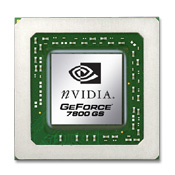Page 2
Inside the graphics processor
Allow me to talk swiftly about the graphics core of the GeForce 7800 GS.
 The Codename: We always love them. The 7800 GS series (and at one point I really do expect an PCI-Express version) has been developed under the G70 family of GPU's, G70 who we all know and love as it's called the GeForce 7800 GTX.
The Codename: We always love them. The 7800 GS series (and at one point I really do expect an PCI-Express version) has been developed under the G70 family of GPU's, G70 who we all know and love as it's called the GeForce 7800 GTX.
NVIDIA_BR02.DEV_00F5.1 = "NVIDIA GeForce 7800 GS"
The core: So in fact the 7800 GS is simply a G70 core with disabled vertex and pixel units. The core has 302 million transistors and is based on a .11 micron fabrication process.
Small note here: you can not enable disabled pipelines or vertex units with Rivatuner ! It's simply not possible.
The clockworks: the standard AGP version of the 7800 GS will be clocked at 375 MHz for the graphics processor and 2x600 on the memory. Memory is gDDR3 with a 38.4 GB/sec theoretical bandwidth. That's great memory bandwidth for sixteen pipeline product. XFX however as explained on the previous page already will clock the card much faster at default for you.
| Specs | GeForce 6600 | GeForce 6600 GT | GeForce 6800 | GeForce 6800 GS | GeForce 6800 GT | GeForce 6800 Ultra | GeForce 7800 GS | GeForce 7800 GT | GeForce 7800 GTX |
| Codename | NV43 | NV43 | NV42 | NV42 | NV40GT | NV40U | G70 | G70 | G70 |
| Transistors | ? | ? | 222 million | 302 million | 302 million | 302 million | |||
| Process, GPU maker | 110nm | 110nm | 130nm | 110nm pcx 130nm agp |
130nm | ||||
350 AGP 350MHz 400MHz 375 MHz 400 MHz 430 MHzMemory 128MB DDR1 128MB GDDR3 128MB DDR1 128/256MB gDDR3 256MB GDDR3Memory bus 128-bit 256-bitMemory clock Up to manufacturer 2x500 MHz 2 x 325MHz 2x
500MHz 2 x 500MHz 2 x 600MHz 2 x 500MHz 2 x 600MHzPCB P212 P212 P2?? P210 P210 -Pipelines 8 8 12 16 16 16 20 24FP operations FP16, FP32DirectX DirectX 9.0cPixel shaders Pixel Shaders 3.0Vertex shaders Vertex Shaders 3.0OpenGL 1.5+ (2.0) 2.0Availability NowNVIDIA reference specification
What is a shader ? What do we need to render a three dimensional object; 2D on your monitor? We start off by building some sort of structure that has a surface, that surface is being built from triangles and why triangles? They are quick to calculate. How's each triangle being processed? Each triangle has to be transformed according to its relative position and orientation to the viewer. Each of the three vertices the triangle is made up of is transformed to its proper view space position. The next step is to light the triangle by taking the transformed vertices and applying a lighting calculation for every light defined in the scene. At last the triangle needs to be projected to the screen in order to rasterize it. During rasterization the triangle will be shaded and textured.
